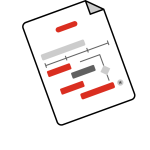Omniscien » Language Studio » Features » Convert »
Supported File Types
Language Studio supports a wide range of file formats. Convert one or more files of the same type to another type by simply dragging and dropping (or uploading) your files and selecting the output format.
New file types are added on a regular basis. The below file type categories are supported in the current release:
Archive
 An archive file is a computer file that is composed of one or more files along with metadata. Archive files are used to collect multiple data files together into a single file for easier portability and storage, or simply to compress files to use less storage space. Archive files often store directory structures, error detection and correction information, arbitrary comments, and sometimes use built-in encryption.
An archive file is a computer file that is composed of one or more files along with metadata. Archive files are used to collect multiple data files together into a single file for easier portability and storage, or simply to compress files to use less storage space. Archive files often store directory structures, error detection and correction information, arbitrary comments, and sometimes use built-in encryption.
- Packing: 7z, XZ, BZIP2, GZIP, TAR, ZIP and WIM
- Unpacking only: 7z, XZ, BZIP2, GZIP, TAR, ZIP, WIM, APFS, AR, ARJ, CAB, CHM, CPIO, CramFS, DMG, EXT, FAT, GPT, HFS, IHEX, ISO, LZH, LZMA, MBR, MSI, NSIS, NTFS, QCOW2, RAR, RPM, SquashFS, UDF, UEFI, VDI, VHD, VHDX, VMDK, WIM, XAR and Z.
| Format | Description | Read | Write |
|---|---|---|---|
| 7Z | 7-Zip Compressed File | ||
| ARJ | Archiver Robert Jung | ||
| BZIP2 | Burrows–Wheeler algorithm, compressed archive file | ||
| CAB | Cabinet File | ||
| CHM | Compiled HTML Format | ||
| CPIO | Copy Input/Output | ||
| FAT | File Allocation Table | ||
| GZIP | GNU ZIP | ||
| HFS | Hierarchical System Format | ||
| ISO | International Organization for Standardization | ||
| LHZ | Lempel-Ziv-Huffman, compressed archive file | ||
| LZMA | Lempel-Ziv-Markov chain Algorithm, compressed archive file | ||
| NSIS | Nullsoft Scriptable Install System, compressed archive file | ||
| NTFS | New Technology File System, compressed archive file | ||
| RAR | WinRAR Compressed Archive | ||
| RPM | Red Hat Package Manager | ||
| TAR | Tape Archive File | ||
| UDF | Universal Disk Format File | ||
| WIM | Windows Imaging Format | ||
| Z | Unix compressed | ||
| ZIP | Compressed Archive File |
Audio
 An audio file is a file format for storing digital audio data on a computer system. The bit layout of the audio data (excluding metadata) is called the audio coding format and can be uncompressed, or compressed to reduce the file size (often using lossy compression). The data can be a raw bitstream in an audio coding format, but it is usually embedded in a container format or an audio data format with defined storage layer.
An audio file is a file format for storing digital audio data on a computer system. The bit layout of the audio data (excluding metadata) is called the audio coding format and can be uncompressed, or compressed to reduce the file size (often using lossy compression). The data can be a raw bitstream in an audio coding format, but it is usually embedded in a container format or an audio data format with defined storage layer.
Convert between audio formats or extract audio from any video file.
| Format | Description |
|---|---|
| 8SVX | Amiga 8SVX |
| AAC | Advanced Audio Coding |
| AC3 | AC3 Audio File |
| AIFF | Audio Interchange File Format |
| ALAC | Apple’s Lossless Audio Codec |
| AMB | Ambisonic B-Format |
| AU | Sun Microsystems AU File Format |
| AVR | Audio Visual Research File Format |
| CAF | Core Audio Format |
| DSD | Direct Stream Digital |
| FAP | PARIS Audio File |
| FLAC | Free Lossless Audio Codec |
| GSM | GSM 06.10 Lossy Speech Compression |
| M4A | Compressed Audio File Format |
| M4R | MPEG 4 Ringtones Audio |
| MP2 | MPEG-1/2 Audio Layer 2 |
| MP3 | MP3 Audio Format |
| NIST | NIST (National Institute of Standards and Technology) File Format |
| OGG | Ogg Vorbis Compressed Audio Fiel |
| OGV | Ogg Vorbis |
| SPX | Speex |
| TTA | True Audio |
| VOC | Sound Blaster VOC File Format |
| WMA | Windows Media Audio |
| WAV | Waveform Audio File Format |
| WV | WavPack Lossless Audio Compression |
Computer-Aided Design (CAD)

Computer Aided Design (CAD) is a form of digital design that allows users to create, modify and manage 2D and 3D models. A CAD file contains a blueprint, schematic, technical drawing or 2D/3D rendering of an object. CAD data exchange file formats are used to exchange drawing data and to translate between different Computer-aided design (CAD) authoring systems or between CAD and other downstream CAx systems. Many companies use different CAD systems and exchange CAD data files with suppliers, customers, and subcontractors.
There are many different file formats available for CAD files, but the most common formats are DWG (AutoCAD), DXF (AutoCAD), IGES (Inventor), STL (3D Systems) and SVG (Scalable Vector Graphics).
| Format | Description |
|---|---|
| COMING SOON |
Data
 A data file is a computer file which stores data to be used by a computer application or system, including input and output data. Many computer applications use XML and JSON data files. For simple data storage, CSV or TSV are also a very common formats that are easily imported into a spreadsheet tool such as Microsoft Excel. The most simple data file is a TXT (plain text) file where the data is not structured and is simple text only.
A data file is a computer file which stores data to be used by a computer application or system, including input and output data. Many computer applications use XML and JSON data files. For simple data storage, CSV or TSV are also a very common formats that are easily imported into a spreadsheet tool such as Microsoft Excel. The most simple data file is a TXT (plain text) file where the data is not structured and is simple text only.
Document
 A document file contains formatted information that includes layout, fonts, styles (bold, italic, underline, etc.), page margins, headings, bullets and numbers, diagrams, images, etc. Some document formats are used in word processors such as Microsoft Word or Google Docs, while others such as PDF (Portable Document Format) are intended for publication and are not normally editable.
A document file contains formatted information that includes layout, fonts, styles (bold, italic, underline, etc.), page margins, headings, bullets and numbers, diagrams, images, etc. Some document formats are used in word processors such as Microsoft Word or Google Docs, while others such as PDF (Portable Document Format) are intended for publication and are not normally editable.
Formats such as PDF can be challenging to convert to editable formats such as Microsoft Word as all the editing information has been removed and therefore must be reverse engineered in order to produce an editable document. Language Studio uses AI to determine the structure of table borders, page margins, headers, footers, and other document structural elements.
Other Microsoft Office formats are also supported, including Presentations and Spreadsheets.
| Format | Description |
|---|---|
| CHM | Compiled HTML Format |
| DOC | Microsoft Word DOC Format |
| DOCM | Microsoft Word DOC Format Macro enabled |
| DOCX | Microsoft Word DOCX Format |
| DOT | Microsoft Word DOC Template files |
| DOTX | Microsoft Word DOCX Template files |
| HTML | Hypertext Markup Langauge |
| MD | MarkDown Documentation |
| MHTML | MIME HTML |
| ODT | OpenDocument Text File format |
| OPC | FlatOPC |
| OTT | Template Documents in compliance with OASIS’ OpenDocument Standard Format |
| PCL | Printer Command Language |
| Portable Document Format | |
| Portable Document Format -Standard | |
| PS | PostScript (a general purpose page description langauge) |
| PUB | Microsoft Publisher Document |
| RTF | Rich Text Format |
| TEX | LaTeX Document Format |
| WP/WP6/WP7 | Word Perfect Format |
| WPT | Word Perfect Template |
| XHTML | Text Based File with Markup in XML |
| XPS | XML Paper Specification |
eBook
 An eBook (short for electronic book), also known as an e-book or an ebook, is a book publication made available in digital form, consisting of text, images, or both, readable on the flat-panel display of a computer or other electronic device. Although sometimes defined as “an electronic version of a printed book”, some eBooks exist without a printed equivalent. eBooks can be read on dedicated e-reader devices, but also on any computer device that features a controllable viewing screen, including desktop computers, laptops, tablets and smartphones.
An eBook (short for electronic book), also known as an e-book or an ebook, is a book publication made available in digital form, consisting of text, images, or both, readable on the flat-panel display of a computer or other electronic device. Although sometimes defined as “an electronic version of a printed book”, some eBooks exist without a printed equivalent. eBooks can be read on dedicated e-reader devices, but also on any computer device that features a controllable viewing screen, including desktop computers, laptops, tablets and smartphones.
| Format | Description |
|---|---|
| EPUB | Electronic Publisher Format |
| MOBI | Mobipocket eBook |
 Email is a common means of communication for businesses and individuals alike and Email clients are used to send and receive email messages, as well as manage other aspects of your email account. The email clients use a variety of email file formats to store their various data including email messages, attachments, folders and address books, etc.
Email is a common means of communication for businesses and individuals alike and Email clients are used to send and receive email messages, as well as manage other aspects of your email account. The email clients use a variety of email file formats to store their various data including email messages, attachments, folders and address books, etc.
There are several common email file types. The most common type of file extension associated with email is EML (Outlook Express Message File). PST (Microsoft Outlook’s Personal Storage Table) is a popular format that stores many emails in one place for quick and retrieval. Emails may be stored with attachments embedded and are typically formatted as HTML and plain text within the format of each specific file type.
| Format | Description |
|---|---|
| COMING SOON |
Feed / Syndication
 A web/news feed or syndication is a data format used for providing users with frequently updated content. Content distributors syndicate a web feed, allowing users to subscribe a channel to it by adding the feed resource address to a news aggregator client / feed reader / news reader.
A web/news feed or syndication is a data format used for providing users with frequently updated content. Content distributors syndicate a web feed, allowing users to subscribe a channel to it by adding the feed resource address to a news aggregator client / feed reader / news reader.
| Format | Description |
|---|---|
| ANPA | IPTC ANPA News Wire feed format |
| ATOM | Atom Syndication Format |
| RSS | Rich Site Summary |
Font
 Fonts are a crucial part of the way we interact with computers. The file formats that allow us to store and access fonts have been improving steadily over time, but the latest versions are truly impressive. Modern fonts can handle complex scripts like Arabic and Hebrew, support multiple languages at once (like English plus Chinese), provide more accurate metrics for shaping glyphs based on their intended usage (for example in small sizes or large sizes), and they can also have multiple colors.
Fonts are a crucial part of the way we interact with computers. The file formats that allow us to store and access fonts have been improving steadily over time, but the latest versions are truly impressive. Modern fonts can handle complex scripts like Arabic and Hebrew, support multiple languages at once (like English plus Chinese), provide more accurate metrics for shaping glyphs based on their intended usage (for example in small sizes or large sizes), and they can also have multiple colors.
Popular file formats include TTF (TrueType Font), OTF (OpenType Font), CFF (CFF Font), and EOT (Embedded OpenType).
| Format | Description |
|---|---|
| COMING SOON |
Image
 Image file types are classified into raster image formats and vector image formats. The files in this category are raster images – digital images that comprise of pixels data for representation of colors. There are two main types of raster image formats – lossless and lossy. Lossless means that no information is lost when the file is opened and viewed — the same as it was when it was first created; whereas lossy means that some information has been lost due to compression algorithms being applied during the creation process (which decreases file size but which may also decrease image quality in some cases). These are the most common image types for graphics that are used for the web as well as for digital photos.
Image file types are classified into raster image formats and vector image formats. The files in this category are raster images – digital images that comprise of pixels data for representation of colors. There are two main types of raster image formats – lossless and lossy. Lossless means that no information is lost when the file is opened and viewed — the same as it was when it was first created; whereas lossy means that some information has been lost due to compression algorithms being applied during the creation process (which decreases file size but which may also decrease image quality in some cases). These are the most common image types for graphics that are used for the web as well as for digital photos.
Common raster image file formats include BMP (Bitmap image file), PNG (Portable Network Graphics), GIF (Graphics Interchange File) and JPG (Joint Photographic Experts Group).
| Format | Description |
|---|---|
| APNG | Animated Portable Network Graphics |
| BMP | Bitmap Raster Image |
| DCM | DICOM (Digital Imaging and Communications in Medicine image) |
| DIB | Device-Independent Bitmap Raster Image |
| DJVU | Graphics File Format |
| DNG | Digital Negative Graphics |
| DXF | Drawing Exchange Format |
| EMZ | Enhanced Metafile |
| GIF | Graphical Interchange Format |
| J2K/JP2 | JPEG 2000 |
| JPEG/JPG | Joint Photographic Experts Group |
| ODG | Open Document Graphics |
| OTG | Open Document Drawing Template File Format |
| PNG | Portable Network Graphic |
| PSD | Photo Shop Document |
| TGA | Raster Graphic Format by Truevision Inc |
| TIF/TIFF | Tagged Image File Format |
| WEBP | Modern Raster Web Image |
Localization
 Localization file formats are designed for two very distinctive roles and purposes – to assist translation professionals in translation by leveraging previous translations or pre-defined terminology, and as a localization resource file where a user can switch between locales/languages within an application.
Localization file formats are designed for two very distinctive roles and purposes – to assist translation professionals in translation by leveraging previous translations or pre-defined terminology, and as a localization resource file where a user can switch between locales/languages within an application.
Translation memories are used to recall previous translations and match against new strings to be translated and also to share translation files between users or when outsourcing content localization. The most common file format for translation memories in XLIFF (XML Localization Interchange Format), with variants created by a number of vendors that have their own vendor specific extensions. TBX (Term Base Exchange) is the most common terminology exchange format. All CAT (Computer Aided Translation) tools will support XLIFF. Many will also support still the legacy TMX (Translation Memory Exchange) format, although this is now a defunct standard.
There are many application localization files with many formats that are specific to the programming language in which they were written. Popular file formats include PO (Portable Object), POT (Portable Object Template), YAML (Yet Another Markup Language / YAML Ain’t Markup Language) and RESX (.NET Managed Resources File).
| Format | Description |
|---|---|
| MQLXLIFF | memoQ XML Localization Interchange Format (XLIFF Variant) |
| SDLXLIFF | SDL XML Localization Interchange Format (XLIFF Variant) |
| TBX | Term Base Exchange |
| TMX | Translation Memory Exchange |
| XLIFF/XLF | XML Localization Interchange Format |
Presentation
 Presentation files are a type of document that stores information regarding the look and feel of slides, animations, and other presentation data. Presentation files also store important information such as: text, embedded objects, audio/video files and shapes.
Presentation files are a type of document that stores information regarding the look and feel of slides, animations, and other presentation data. Presentation files also store important information such as: text, embedded objects, audio/video files and shapes.
The most common presentation file file format is PPTX (Microsoft Powerpoint). Many presentations are also converted into PDF (Portal Document Format) when they need to be shared with others as a published document.
Other Microsoft Office formats are also supported, including Documents and Spreadsheets.
| Format | Description |
|---|---|
| ODP | OpenDocument Presentation |
| POT | Microsoft PowerPoint 97-2003 Template |
| POTM | Microsoft PowerPoint Template with Macros Enabled |
| POTX | Microsoft PowerPoint Template |
| PPS | PowerPoint Slide Show 97/2000/XP |
| PPSM | PowerPoint Slide Show with Macros Enabled |
| PPSX | PowerPoint Slide Show |
| PPT | Microsoft PowerPoint 97/2000/XP |
| PPTM | Microsoft PowerPoint with Macros Enabled |
| PPTX | Microsoft PowerPoint |
Project and Task
 Project files are an essential part of any project management system. Files are used to store tasks, resources, and scheduling to get a measurable output in the form of a product or a service. The most common file format for project files is MPP from Gantt charts can be created and exported as PDFs or images for documentation purposes. Additional file formats include MPX which is used by Microsoft Project and XER which is used by Excel.
Project files are an essential part of any project management system. Files are used to store tasks, resources, and scheduling to get a measurable output in the form of a product or a service. The most common file format for project files is MPP from Gantt charts can be created and exported as PDFs or images for documentation purposes. Additional file formats include MPX which is used by Microsoft Project and XER which is used by Excel.
| Format | Description |
|---|---|
| COMING SOON |
Spreadsheet
 Spreadsheets are one of the most versatile data-handling tools available. With a spreadsheet, you can organize and analyze your data in many different ways, including tables, graphs and charts. Spreadsheets are a great way to organize your data, but sometimes you need to save your spreadsheet in a different file format.
Spreadsheets are one of the most versatile data-handling tools available. With a spreadsheet, you can organize and analyze your data in many different ways, including tables, graphs and charts. Spreadsheets are a great way to organize your data, but sometimes you need to save your spreadsheet in a different file format.
The most common file extension for spreadsheets is XLSX (Microsoft Excel Open XML Spreadsheet), but there are other options as well. Other common extensions include ODS (OpenDocument Spreadsheet), XLS (Microsoft Excel Binary File Format) and CSV (Comma Separated Value).
Other Microsoft Office formats are also supported, including Presentations and Documents.
| Format | Description |
|---|---|
| ODS | OpenDocument Spreadsheet |
| OTS | Open Document Spreadsheet Template File Format |
| XLS | Microsoft Excel XLS Format |
| XLSB | Microsoft Excel Binary Spreadsheet |
| XLSX | Microsoft Excel XLSX Format |
Subtitle / Caption
 Subtitles and captions are lines of dialogue or other text displayed at the bottom of the screen in films, television programs, video games or other visual media. Subtitles refer to a text translation of audio into a different language and are for people who can hear the audio, but may not be able to understand the dialogue. Captions are text in the language of the audio and are designed for anyone unable to hear the audio, they often also contain descriptions of important sounds that would not normally be perceived by anyone who is unable to hear the audio.
Subtitles and captions are lines of dialogue or other text displayed at the bottom of the screen in films, television programs, video games or other visual media. Subtitles refer to a text translation of audio into a different language and are for people who can hear the audio, but may not be able to understand the dialogue. Captions are text in the language of the audio and are designed for anyone unable to hear the audio, they often also contain descriptions of important sounds that would not normally be perceived by anyone who is unable to hear the audio.
The most common file type for subtitles in the SRT (SubRip Text Format) format. However, TTML (Timed Text Markup Language) is the dominant standard with more advanced editors and newer applications.
| Format | Description |
|---|---|
| DFXP | Distribution Format Exchange Profile |
| PAC | Screen Subtitling Systems PAC Format |
| SCC | Scenarist Closed Captions |
| SRT | SubRip Text Format |
| SUB | MicroDVD Subtitle |
| TTML | Timed Text Markup Language |
| VTT | Web Video Text Tracks (WebVTT) |
Vector
 Vector graphics are different because they don’t use pixels at all (unlike raster / bitmap graphics)—they’re made up entirely of mathematical calculations called vectors instead! This means that they can scale. Vector images are stored as mathematical formulas rather than pixelated pieces of color. Images are created directly from geometric shapes defined on a Cartesian plane, such as points, lines, Curves and polygons.
Vector graphics are different because they don’t use pixels at all (unlike raster / bitmap graphics)—they’re made up entirely of mathematical calculations called vectors instead! This means that they can scale. Vector images are stored as mathematical formulas rather than pixelated pieces of color. Images are created directly from geometric shapes defined on a Cartesian plane, such as points, lines, Curves and polygons.
Vector graphics are often used for illustrations, graphic design , computer-aided design, and geographic information systems, but can also be used to represent photographs and other pictures. Common file types include AI (Adobe Illustrator Artwork) , PSD (Adobe Photoshop Document) and SVG (Scalable Vector Graphics).
| Format | Description |
|---|---|
| AI | Adobe Illustrator Artwork |
| CDR | CorelDRAW |
| CMX | Corel Metafile Exchange |
| EMF | Enhanced Windows Metafile |
| EPS | Encapsulated PostScript |
| PSB | Photoshop Large Document Format |
| PSD | Adobe Photoshop Document |
| SVG | Scalable Vector Graphics |
| SVGZ | Compressed Version of Scalable Vector Graphics |
| WMF | Microsoft Windows Metafile |
| WMZ | Compressed Version of WMF |
Video
 Video file formats are used by computers to store digital media. Because of the increasing popularity of video content, a number of different types of video file formats are available for use. There are many different factors, including file size and quality, that can assist in determining which format you should use for your videos.
Video file formats are used by computers to store digital media. Because of the increasing popularity of video content, a number of different types of video file formats are available for use. There are many different factors, including file size and quality, that can assist in determining which format you should use for your videos.
The most popular video formats are AVI (Audio Video Interleave), MOV (QuickTime Movie), WMV (Windows Media Video), M4V (MPEG-4) and MP4 (MPEG-4). All these formats support high definition videos with different quality levels ranging from 480p to 1080p and above.
A video can also be converted into an audio file format that contains the audio only from the original video.
| Format | Description |
|---|---|
| AVI | Audio Video Interleave |
| F4V | Flash video formats |
| FLV | Flash video formats |
| HTML5 | AudioVisual media file format |
| M2TS | MPEG-2 Transport Stream |
| MKV | Matroska Multimedia Container |
| MOV | QuickTime Movie |
| MP4 | MPEG-4 Part 14 |
| WEBM | WEB Media |





